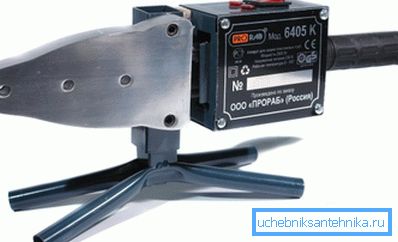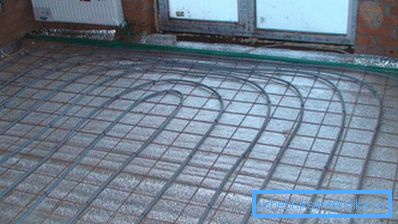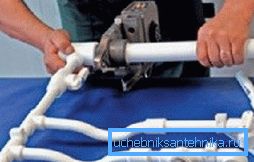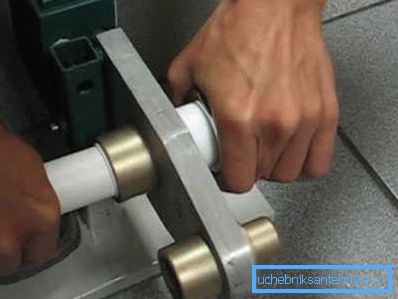Plastic pipe welding: features of the work
Metal pipes in a human home gradually disappear, they are replaced by plastic analogues. Polypropylene pipe is universally used for the installation of plumbing and heating systems, and the tightness of the connection is achieved by soldering (welding). It is also important that welding plastic pipes with your own hands guarantees the desired strength and durability of the joint.

Still an iron or a soldering iron?
Having heard these names in relation to welding, know that this is one and the same unit. Since welding takes place quietly, without the usual sparks and flashes of light and the parts are soldered - it is logical to call the unit a soldering iron. A part of the body with special nozzles has the shape of an iron sole and the same “nickname”.

The general principle of operation of an electric soldering iron is to heat the external surface of the pipeline and the internal fitting with special nozzles. Having become plastic, these surfaces, having joined and cooled down, form a single whole.
The choice of a soldering iron does not tolerate vanity
Before you choose a machine for welding plastic pipes, first of all, pay attention to its power. And not so much to weld pipes with a diameter of more than 60 mm (in an apartment such quantities are not expected), but to accelerate the process. Good power speeds up the workflow - warming up takes less time, and 1.2 - 1.5 kW will be more than enough.
Make sure that the kit contains instructions, quite a variety of nozzles (16 - 40 mm). Dokupat such trivia is extremely inconvenient and at a price they will be higher. Coverage of nozzles matters - metallized Teflon or just Teflon is more wear-resistant and warms up evenly.

A device for welding plastic pipes can have several nozzles in the kit, which improves performance. The “homeland” of the apparatus is also of considerable importance when choosing. If Chinese samples allow you to save money, then, for example, the Czech brand Daitron will be expensive, but with guaranteed quality.
Features of plastic piping
The advantages of a plastic pipeline, which are manifested in their price and operational properties, cannot overshadow the lack of linear expansion at high temperatures. For the installation of water and heating systems successfully used plastic, and more precisely polypropylene pipes (PPR). You will also have to purchase the necessary fittings, but their price is low.

In the metal-plastic pipes (PPR-AL-PPR) between the layers of plastic is an aluminum layer, which gives them additional strength, the ability to store bending geometry. They are ideal for heating systems, maintaining water temperatures up to 95 ° C.

The color palette of the PPR pipeline is white, gray and optimistic green, it has no meaning and welding is not contraindicated for plastic pipes of different colors. But black color means enhanced resistance to sunlight.
Pipe system installation - general plan
Replacing a part of the system or its complete update begins with a plan, according to which the optimal variant of the location of pipe lines, strategic connection points, connection to units, installation of cranes, etc., is calculated.
When the general plan has been drawn up, it is time to implement its individual items, namely the welding of fragments of the system. Their complex configuration is more convenient to assemble on a horizontal surface. For this, a soldering iron for welding plastic pipes is equipped with a stable stand.

When the finished sections will be assembled together, the pipeline must additionally be fixed on the wall with clamps. If vertical welding on a wall or in an inaccessible place is necessary, an assistant must be nearby to keep the soldering iron on weight, because it is unrealistic for one to perform such an operation.
Welding technical support
In addition to the soldering iron with a set of nozzles, fittings and plastic pipes, the main components of the welding process, you will also need:
- pipe cutter (scissors, grinder, or at least sawing wood);
- shaver (removes the reinforcing layer);

- chamfering device;
- retailer.
Completed equipment for welding plastic pipes will allow you to concentrate directly on the working process, without being distracted by the search for alternative options from the series - what would it be to replace !?
Welding preparation
- The necessary fragment is cut off with scissors or a pipe cutter at a right angle. When using grinders or saws on wood, the cut is unclean, in burrs, which are removed by a razhodnimitel;

- The outer edge of the cut you need to round - make a chamfer. (International standards for tilting chamfers differ - Germans require a 15-degree tilt with a thickness of 2 - 3 mm, in Russia, respectively - 45 ° and 1/3. Any value between these figures will be your middle ground);
- Welding of metal-plastic pipes involves the removal of the upper plastic and inner aluminum layer by the shaver. In other PPR pipes, the upper layer at the soldering point is also removed, because the internal diameter of the cold fitting is always slightly less than the external diameter;

- For guaranteed tightness of the connection, the ends of the plastic must be cleaned, degreased and dried;
- A restrictive coupling is installed on the pipe, which determines the depth of the end entrance to the sleeve.
Note! It is recommended to use piping and fittings from the same manufacturer. Otherwise, poor connection is possible.
Attention, it is welding!
The machine for welding plastic pipes is installed on a horizontal surface of a convenient height with a free approach to it from either side.
Further work is carried out in the following sequence:
- before switching on the unit, install nozzles (sleeve, mandrel) corresponding to the diameter of the pipe and fitting;
- Set the controller to the required temperature of 260 ° (this is a standard value, and you should not change it);
- turn on the soldering iron in the network and the button on the case. The green indicator light shows the heating process (10 - 15 minutes), red indicates that the desired temperature has already been reached;
- two hands at the same time insert the pipe into the sleeve to the stop indicated by the coupling and put the fitting on the mandrel;

- after 5 - 6 seconds we remove the pipe and fitting from the nozzles and connect them in an even movement, without rotating and not bending, so that their axes coincide;
- blow into the pipeline and make sure that the permeability is not broken;
- after work, turn off the soldering iron and wipe the nozzles while they are still warm from the remnants of plastic with a rag or wooden spatula.
Note! Scraping the production waste from the already cooled Teflon nozzles, you can scratch the surface. Burrs may appear that will put the leak tightness issue at risk.
Summarizing
Welding plastic pipes is a fairly simple task. To do this, you just need to follow the instructions exactly. In this case, a strong and durable joint is guaranteed, and the pipeline will last more than one decade.
The video in this article will teach the basics of working with plastic pipes.